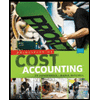
1.
Sales mix: It refers to the relative distribution of the total sales among the number of products sold by a company. In other words, it is expressed as a percentage of units sold for each product with respect to the total units sold for all the products.
Break-even Point: It refers to a point in the level of operations at which a company experiences its revenues generated is equal to its costs incurred. Thus, when a company reaches at its break-even point, it reports neither an income nor a loss from operations. The formula to calculate the break-even point in sales units is as follows:
To determine: the break-even point in sales units for the overall Product E for the current year.
1.
Explanation of Solution
Determine the break-even point in sales units for the overall Product E.
Fixed cost =$46,800
Contribution margin per unit =$10.40 per unit (3)
Working notes:
Note: For break-even analysis, the Product-12” Pizza and Product-13” Pizza are considered as the components of one overall company’s Product E.
Determine the selling price per unit of Product E.
Determine the variable cost per unit of Product E.
Determine the unit contribution margin of Product E.
Therefore, the break-even point in sales units for the overall Product E for the current year is 4,500 units.
2.
the break-even sales (units) for Product-12” Pizza and Product-16” Pizza.
2.
Explanation of Solution
Determine the break-even point in sales units:
For Product-12” Pizza
Break-even point in sales units for Product E =4,500 units (refer Part a)
Sales Mix for Product Laptops =30%
For Product-16” Pizza
Break-even point in sales units for Product E =4,500 units (refer Part a)
Sales Mix for Product Tablets =70%
Therefore, the break-even point in sales units for the Product 12” Pizza is 1,350 units and for the Product 16” Pizza is 3,150 units.
3.
To compare: the break-even point with that in Part (1).
3.
Explanation of Solution
The break-even point calculated in (1) with a sales mix of 50% 12” Pizza and 50% 16” Pizza is 4,680 units. It is more than the break-even point of 4,500 units calculated in Part 1.
The reason for the difference is the sales mix which is allocated at a lower percentage to the 12” Pizza (50%) and 16” Pizza (50%) in the present case. It resulted in the lower contribution margin per unit of $10.00 per unit than in Part 1 ($10.40 per unit). Thus, it increases the break-even point of sales (units) in the present case.
Working notes:
Determine the break-even point in sales units for the overall Product E.
Fixed cost =$46,800
Contribution margin per unit =$10.00 per unit (7)
Note: For break-even analysis, the Product-12” Pizza and Product-16” Pizza are considered as the components of one overall company’s Product E.
Determine the selling price per unit of Product E.
Determine the variable cost per unit of Product E.
Determine the unit contribution margin of Product E.
Determine the break-even point in sales units:
For Product-12” Pizza
Break-even point in sales units for Product E =4,680 units (4)
Sales Mix for Product 12” Pizza =50%
For Product-16” Pizza
Break-even point in sales units for Product E =4,680 units (4)
Sales Mix for Product 16” Pizza =50%
Want to see more full solutions like this?
Chapter 21 Solutions
CUSTOM PKG FOR AC114
- General accounting questionarrow_forwardA company uses the weighted-average method for inventory costing. At the end of the period, 19,500 units were in the ending Work in Process inventory and are 100% complete for materials and 72% complete for conversion. The equivalent costs per unit are; materials, $2.75, and conversion $2.40. Compute the cost that would be assigned to the ending Work in Process inventory for the period.arrow_forwardWhat is the amount of manufacturing overhead incurred by silverstone ? General accountingarrow_forward
- For the Crestview Manufacturing Company, the average age of accounts receivable is 50 days, the average age of accounts payable is 40 days, and the average age of inventory is 68 days. Assuming a 365-day year, what is the length of the firm's cash conversion cycle?arrow_forwardHello tutor please provide correct answer general accounting question with correct solution do fastarrow_forwardCan you demonstrate the accurate method for solving this general accounting question?arrow_forward
 Managerial AccountingAccountingISBN:9781337912020Author:Carl Warren, Ph.d. Cma William B. TaylerPublisher:South-Western College PubPrinciples of Accounting Volume 2AccountingISBN:9781947172609Author:OpenStaxPublisher:OpenStax College
Managerial AccountingAccountingISBN:9781337912020Author:Carl Warren, Ph.d. Cma William B. TaylerPublisher:South-Western College PubPrinciples of Accounting Volume 2AccountingISBN:9781947172609Author:OpenStaxPublisher:OpenStax College Cornerstones of Cost Management (Cornerstones Ser...AccountingISBN:9781305970663Author:Don R. Hansen, Maryanne M. MowenPublisher:Cengage Learning
Cornerstones of Cost Management (Cornerstones Ser...AccountingISBN:9781305970663Author:Don R. Hansen, Maryanne M. MowenPublisher:Cengage Learning Financial And Managerial AccountingAccountingISBN:9781337902663Author:WARREN, Carl S.Publisher:Cengage Learning,
Financial And Managerial AccountingAccountingISBN:9781337902663Author:WARREN, Carl S.Publisher:Cengage Learning, Principles of Cost AccountingAccountingISBN:9781305087408Author:Edward J. Vanderbeck, Maria R. MitchellPublisher:Cengage Learning
Principles of Cost AccountingAccountingISBN:9781305087408Author:Edward J. Vanderbeck, Maria R. MitchellPublisher:Cengage Learning Managerial Accounting: The Cornerstone of Busines...AccountingISBN:9781337115773Author:Maryanne M. Mowen, Don R. Hansen, Dan L. HeitgerPublisher:Cengage Learning
Managerial Accounting: The Cornerstone of Busines...AccountingISBN:9781337115773Author:Maryanne M. Mowen, Don R. Hansen, Dan L. HeitgerPublisher:Cengage Learning





